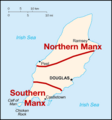Manx language facts for kids
Quick facts for kids Manx |
|
|---|---|
| [y Ghaelg] Error: {{Lang}}: text has italic markup (help), [y Ghailck] Error: {{Lang}}: text has italic markup (help) | |
| Native to | Isle of Man |
| Native speakers | Extinct as a first language in 1974; subsequently revived and now with about a hundred competent speakers, including a small number of children who are new native speakers, and 1,823 people (2.27% de facto population) in the Isle of Man professing some knowledge of the language (2011) |
| Language family | |
| Official status | |
| Official language in | |
| Regulated by | Coonseil ny Gaelgey (Manx Gaelic Council) |
| Linguasphere | 50-AAA-aj |
The Manx language is spoken on the Isle of Man. It is also known as "Gaelg" or "Gailck" in Manx.
Manx is a Celtic language. It belongs to the Goidelic language family. This means it is related to Scottish Gaelic and Irish.
Most people who speak Manx today learned it because they were interested. It almost disappeared as a language used every day in the 20th century. The last person who spoke Manx as their first language died in 1974.
The Manx language is now protected. This is thanks to the European Charter for Regional or Minority Languages.
History of Manx
The Manx language started to become different from Middle Irish around 900 to 1600 AD. Manx speakers call it Yn Ghaelg or Yn Ghailck.
During the 1800s, fewer and fewer people spoke Manx. The English language slowly took its place. In 1901, about 9% of people on the Isle of Man spoke Manx. But by 1921, this number dropped to only 1%.
Today, Manx is making a comeback. It is the only language used for teaching in five pre-schools on the Isle of Man. Manx is also taught as a second language in all primary and secondary schools on the island.
Manx Language Today
There is now a special school where all lessons are taught in Manx. This helps more children learn the language.
A survey in 2001 showed that 2.2% of the island's population could speak Manx. Currently, there are about 54,000 people who speak Manx as a second language. Most of these speakers live on the Isle of Man.
Images for kids
-
William Christian, also known as Illiam Dhone (Brown-haired William).
-
Lag ny Keeilley ("Hollow of the Church") on Cronk ny Arrey Laa ("Hill of the Day Watch"). The Manx language has greatly influenced the names of places on the island.
See also
 In Spanish: Idioma manés para niños
In Spanish: Idioma manés para niños








